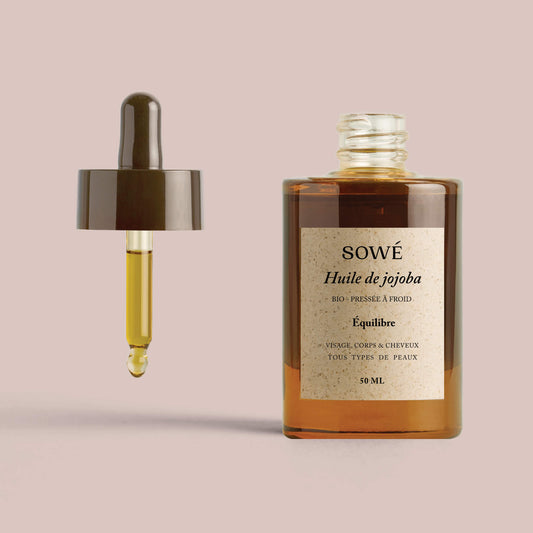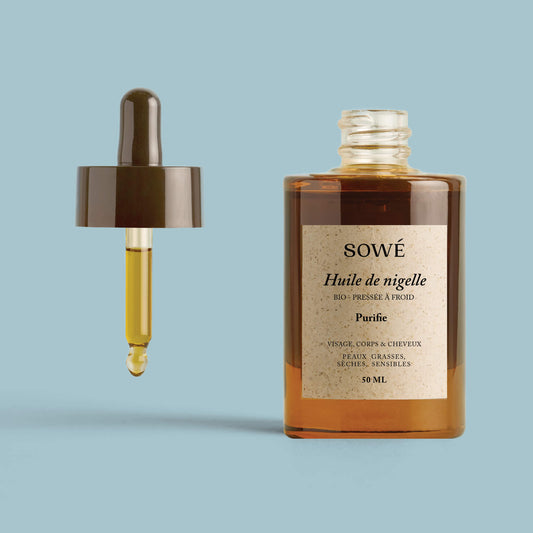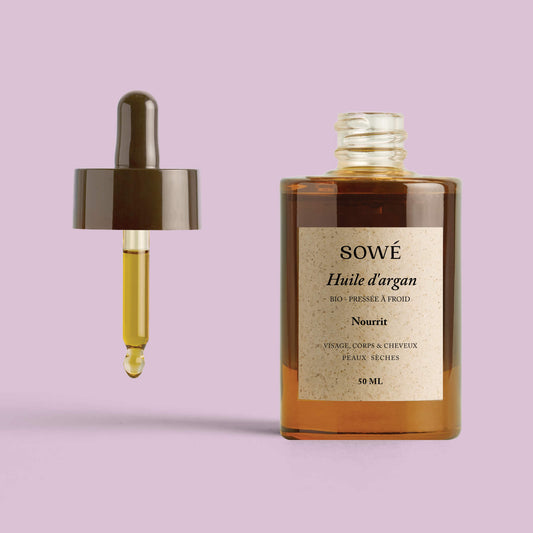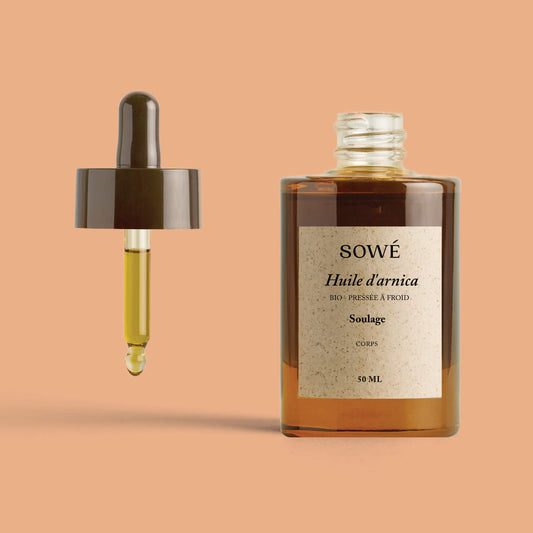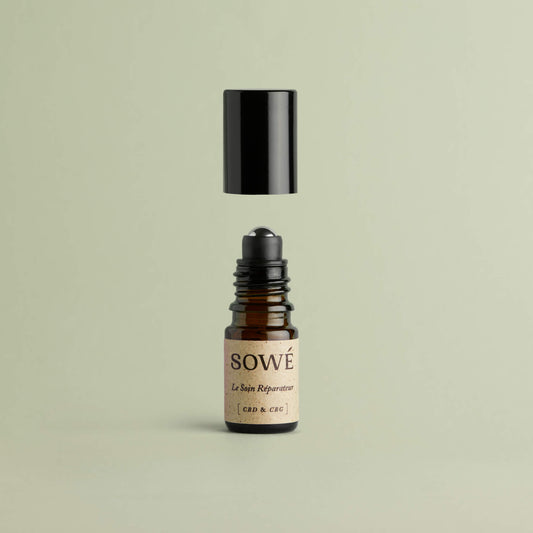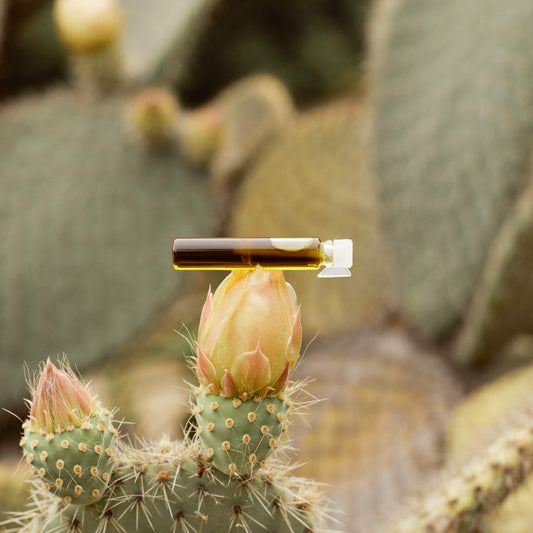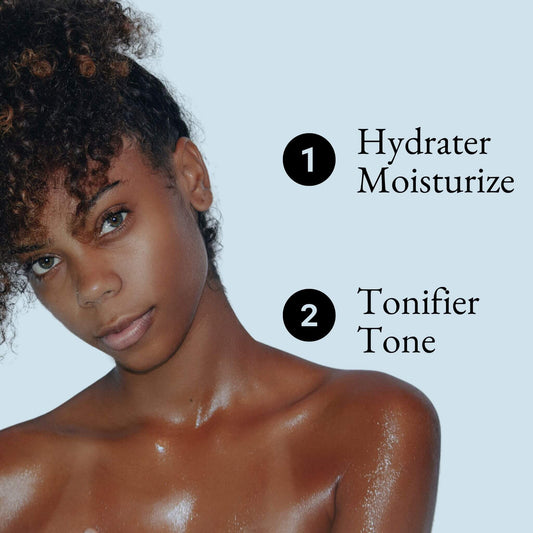Oily skin
Oily skin is easy to diagnose. The first clinical sign is shiny, oily skin, which is particularly noticeable in the T-zone.

Other clues :
- Blackheads
- Uneven skin texture
- Dilated pores
Hyperseborrhoea, the main cause
The scientific term used to describe oily skin is due to an overproduction of sebum. Sebum is an oily substance produced by the sebaceous glands, whose role is to protect the skin from external aggressions. When there is an excess of sebum, the skin becomes shiny, which sometimes gives the impression that it is glowing.
So, can we apply oil to oily skin?
According to our latest survey, 1 in 2 people are reluctant to apply oil to the face. The main fears are the sensation of amplifying the shine, of “over-nourishing” the skin and of causing skin eruptions.
However, the benefits of oil for oily skin are numerous. Rest assured, we will explain how to choose the right oil.
There are 2 things to know before using a vegetable oil on oily skin.
1. The comedogenic index of an oil
2. The comedogenic scale
The comedogenic index of an oil
The word comedogenic comes from the word “comedone”: a small mass of sebaceous matter that clogs a pore of the skin (blackhead).
There is a way to know whether or not a product is good for oily skin
The comedogenicity scale
This scale indicates the likelihood that a given substance will clog your pores. A number between 0 and 5 represents the severity of comedogenicity, 0 being the least comedogenic and 5 the highest.
- Index 0: not at all comedogenic
- Index 1 and 2: slightly comedogenic
- Index 3 and 4: comedogenic
- Index 5: very comedogenic
If you have oily skin, you should choose an oil with the lowest comedogenicity rate, so the closest to 0 on this scale.
The fatty acid content of your oil
Its fatty acid profile will determine its characteristics in terms of touch, substantivity, occlusion capacity and penetration of the oil into the skin.
Oleic acid
If you have acne-prone skin, you should avoid oils rich in oleic acid (an omega-9 monounsaturated fatty acid present in many vegetable oils, including avocado and olive) as this could affect the balance of your skin barrier.
Linoleic acid
Research shows that oily and acne-prone skins tend to have a deficiency in linoleic acid. The level of linoleic acid in an oil is thus a criterion to consider. This unsaturated omega 6 fatty acid (very present in hemp and calendula oil) has the role of readjusting the balance of your skin and maintaining the skin hydration barrier via ceramides, you know, these lipids capable of soothing the “traumas” of the skin.

What vegetal oil choose to use on an oily skin?
Prioritize good vegetable oils on oily skin
Given the information we have shared with you above, you should opt for a non-comedogenic oil, i.e., an oil with a low oleic acid content, but a good amount of linoleic acid. Are you still following?
Prickly pear oil: (comedogenic index=0)
It is rich in vitamin E and sterols, which give it powerful antioxidant properties. It helps fight skin aging, nourishes the skin, and maintains its natural hydration.
Organic argan oil: (comedogenic index=0)
It is non-comedogenic and helps the skin regain its natural balance while naturally hydrating it. Its antioxidant ingredients help repair damaged skin cells.
Jojoba oil: (comedogenic index=0)
It is known for its unparalleled sebum-regulating properties, making it a very effective oil against hyperseborrhea. It has a comedogenicity index of 0, which means it is not likely to clog skin pores.
Organic hemp oil: (comedogenic index = 0
It is rich in essential fatty acids and nutrients, which allows it to maintain the skin’s water balance, prevent dryness, and promote a healthy appearance.
Black seed oil: (comedogenic index = 0)
It is particularly suitable for oily skin prone to acne. It helps fight excess sebum, while treating acne and purifying the epidermis.
Macadamia oil: (comedogenic index = 1 and 2)
It is rich in palmitoleic acid, an omega 7 that is close to the composition of human sebum. It therefore helps maintain good skin and mucous membrane hydration.
In conclusion, in the face of hyperseborrhea and oily skin, the best weapon is therefore the control of this excess sebum to counter the appearance of a greasy film clogging the pores.
Advice for oily skin care
Start by limiting astringent or “stripping” cosmetic products, which remove excess sebum in appearance, but have the side effect of increasing its secretion.
Positive aspects of having oily skin?
Of course! Oily skins are less fragile than dry skins, because sebum is an essential component of the hydrolipidic film that protects the skin and prevents it from drying out.
In addition to protecting against bacteria and external aggressions, the hydrolipidic film allows the skin to better resist skin aging by delaying the appearance of the first wrinkles.
So don’t eliminate sebum production, regulate it!
Sources
- M. Leslie Baumann, Cosmeceuticals and Cosmetic Ingredients, Medical, 2015.
- Downing DT, Stewart ME, Wertz PW, Strauss JS. Essential fatty acids and acne. J Am Acad Dermatol. 1986 Feb;14(2 Pt 1):221-5.












